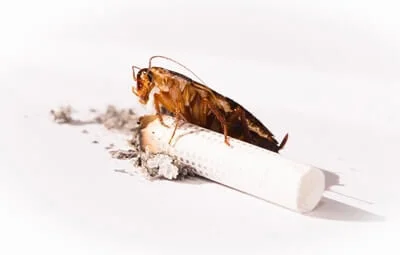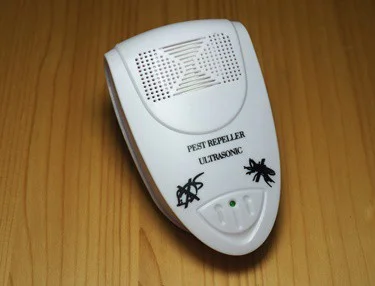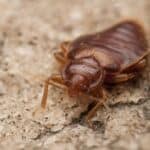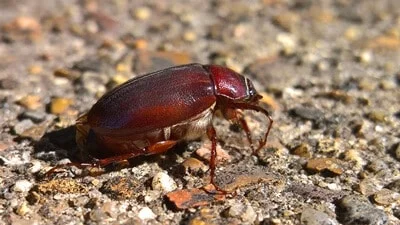Cockroaches seem to eat everything, so it won’t surprise you to find roaches eating cigarettes. If you have found roaches in your ashtray, it’s understandable that you may wonder if they actually like cigarette smoke.
Roaches don’t like cigarette smoke, but they do enjoy eating tobacco and cigarette paper. Both contain carbohydrates, as well as attractive additives and flavorings, such as sugar and cocoa. The nicotine in tobacco is detrimental to roaches, and consumption can lead to paralysis and be fatal if the chemicals stop the heart.
Therefore, tobacco can work as an insecticide. With that said, specific classes of neonicotinoids are banned throughout the world. This is due to their harmful effects on crucial pollinator species, such as honey-bees and avian populations. If you’re looking to use cigarettes as pest control, you’ll have to approach this extremely carefully.
Are Cockroaches Attracted to Cigarettes?
Cockroaches do eat cigarettes. It won’t be their first choice because cigarettes aren’t as nutritious as other foods, such as kitchen scraps. Even organic waste in your bathroom may be healthier for a roach’s metabolism. However, if there are no other options, scavengers like cockroaches will settle for eating:
- Cigarettes
- Cigars
- Cigarette papers
- Tobacco leaves or dust
- Unburned pieces of tobacco in your ashtray
The ash and smoke themselves have no benefits for roaches. In fact, cigarette smoke may deter cockroaches. The smoke can mask smells that roaches are dependent on, such as the pheromones for:
- Attracting mates
- Warning of danger
- Leaving scent trails that lead to food
According to the Journal of Economic Entomology, masking the scent of a female cockroach’s sex pheromone decreases male activity. The study suggests that masking pheromones can be used as a natural anti-roach measure.
While the smell of cigarette smoke can be useful in warding off cockroaches, it is definitely not recommended to begin or continue smoking for that reason alone. Smoking, especially in a closed space, is deleterious to your health and others in your area.
Roaches like cigarettes despite the health risks. Not only are they resilient, but they can gain sustenance from the ingredients found in cigarettes. For example, paper can be a source of carbohydrates. Any flavorings or additives are derived from natural ingredients, like sugar or cocoa beans. That’s not to mention the tobacco itself.
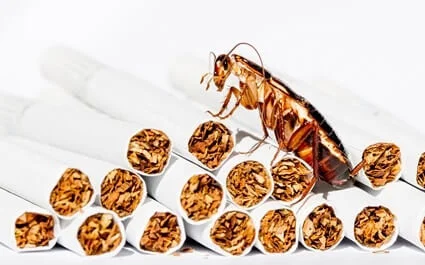
Do Cockroaches Eat Tobacco?
To a cockroach, tobacco is just another plant derivative. If they cannot find other foods, plants can serve as a substitute for the carbohydrates that are required in their diet. According to the National Library of Medicine, dietary carbs for a roach are necessary for:
- Retaining other nutrients
- Increasing weight
- Boosting male pheromone release
Weight gain and male pheromone release are important for attracting mates as this improves the survival rate of a roach population. Likewise, carbs enhance a roach’s sperm count., as discovered by the Proceedings of The Royal Society B. There’s a correlation between the number of sperm that a male cockroach has and its reproductive success. This increases the chances for:
- Successful copulation
- Offspring viability
- Producing more offspring that is biologically theirs
To cockroaches, carbohydrates are a means for them to boost the probability that their genes will be passed onto the next generation, aiding their overall fitness.
Carbohydrates make up 30% of tobacco, as found by the Food and Drug Administration. It takes the form of various sugars that cockroaches find highly desirable.
Moreover, Soil Science and Plant Nutrition found that the timing of when farmers harvest their tobacco plant increases the presence of starch to the maximum level. This adds to the carbohydrates of a cigarette and thus, makes it more attractive to a cockroach.
Cigarette Paper
Along with starch and other carbohydrates within tobacco, modern cigarettes also use specific cigarette paper. It contains cellulose, another common type of plant sugar or carbohydrate. Therefore, cockroaches can eat both the tobacco within a cigarette and the paper that contains it.
Additives and Flavorings
Some cigarettes contain additives and flavorings to make them more palatable. The following table lists some of the additives in cigarettes used to make them more flavorful.
As you can see, there’s a high dose of sugar. Sugar is one of the most attractive substances to a cockroach. That’s because it, itself, is made of carbohydrates:
| Additive | Mass per gram of tobacco |
|---|---|
| Sucrose | 34.5 milligrams |
| Glucose | 52.3 milligrams |
| Fructose | 87.6 milligrams |
| Cocoa | 5-15 milligrams |
| Licorice | Up to 40 milligrams |
With that said, some roaches seem to be sugar-averse, particularly glucose-averse. This sugar avoidance has been hypothesized to develop genetically from roaches. It’s passed down from parents that have survived sugar traps and baits laid out by humans in an attempt to eliminate them.
The ability to detect sugar has many fitness benefits, allowing them to pass such abilities to offspring. If you want to eliminate cockroaches from your home, be aware that using plain sugar may not work 100% of the time.
Cocoa and licorice are other additives that serve as additional sweeteners in cigarettes. Even with sugar-aversion, if the sugar is mixed within a sweet product, roaches may still be highly attracted.
However, some cockroaches seem to dislike the scent or taste of the licorice plant. Many cockroaches are known to be attracted to candy due to its sweet content, so it’s unclear whether licorice flavors will lead to an adverse effect.
The contents of a cigarette are appealing to a cockroach. Even if cigarette smoke may deter roaches, the carbohydrates and other nutrients will still be enticing. Your regular pack of cigarettes may be keeping roaches nearby, even if other food sources are gone.
Does Nicotine Kill Roaches?
Nicotine, one of the chemical components in tobacco, has been found to kill roaches. In fact, using nicotine is considered a green insecticide method. It dates back all the way to the 1690s.
A variety of studies have been conducted to determine the insecticidal and pesticidal properties of tobacco leaves. Findings have shown that the oil produced from tobacco leaves can lead to high mortality rates.
That is when tested against insects such as the potato beetle. A cockroach is not the same organism as a beetle, but the two do possess anatomical similarities. Therefore, these results can extend to other insects.
Insecticidal Properties of Tobacco
For cockroaches, tobacco is one of those things: while they can consume it, should they? Tobacco plants produce a well-known chemical called nicotine, which is a natural defense mechanism against insect predators.
Nicotine acts on the insect’s neurotransmitters. These work via a chemical naturally produced by the cockroach’s nerve cells. It conducts a message cascade throughout different areas of the bug’s body. These message cascades are responsible for a variety of essential bodily movements and information processing.
The insecticidal property of tobacco lies in the nicotine’s ability to work on these crucial nerve cell signals. Nicotine can disrupt a cockroach’s neurotransmitters from sending signals to the muscles of the insects. That includes the heart. It does so by mimicking the structure of the natural neurotransmitters that cockroaches produce. Therefore, it can block the message cascade.
Without these signals, the heart cannot pump blood. As a result, the cockroach can die. However, cockroach death may be dependent on the nicotine levels within the tobacco.
Nicotine still acts the same way, regardless of its concentration. However, it may leave a cockroach paralyzed rather than dead. The difference between a dead and paralyzed cockroach lies in whether or not the limbs or antennas are immobile or twitching. You could use this to your advantage by eliminating the cockroach yourself. You’d need to discover it while the roach is paralyzed from nicotine poisoning.
How to Use Tobacco as a Pesticide
As we’ve learned, insects have a high mortality rate due to tobacco. That means that you can use tobacco as a pesticide. There are two ways:
- Concocting tobacco juice
- Using tobacco dust
Concocting Tobacco Juice
Tobacco juice is easy to make. That ensures this method can be a do-it-yourself pesticide. You only need a few ingredients to make tobacco juice:
- Cigarettes
- Water
- Soap
- Strainer
Here’s how to mix it all together:
- Put 1 cup of cigarette butts into 1 gallon of water.
- After adding the water, add about 10 drops of some mild soap, such as dish or hand soap.
- You should then allow this mixture to steep for at least 30 minutes.
- Once you have steeped your tobacco juice, strain the mix through a strainer or a cloth.
- This removes the tobacco particles and cigarette paper from the cigarette butts placed in the water.
- Now you have a DIY pesticide that can be kept for up to a month.
To use this as a pesticide, pour some tobacco juice into a spray bottle. This allows you to apply it to your plant leaves. Pouring tobacco juice onto plant stems or into the soil also works effectively. When roaches investigate and taste the appealing concoction, they’ll be poisoned.
Tobacco Dust
Tobacco dust is the waste that is produced when creating common tobacco products. It is found in many horticulture stores. After all, it’s useful for fertilizing your plants and acting as a fungicide or pesticide.
You can use tobacco dust as is and sprinkle it over your plants. However, there are ways to apply it more easily and guarantee that it sticks to your plant stems and leaves. The best method is to make tobacco juice from the dust, just as you did with cigarette butts.
Using tobacco dust as a base for your pesticide requires the same tools and ingredients to make tobacco juice. In essence, tobacco dust replaces the cigarette ingredient in the above recipe. You’ll need:
- Tobacco dust
- Water
- Soap
- Strainer
To make tobacco dust into a pesticide:
- Mix 1 cup of tobacco dust with 3-4 liters of water.
- Allow the tobacco dust to soften in the mixture for about 12-24 hours.
- Add 1 tablespoon of soap and put your mix through a strainer.
- You can add this mixture into a spray bottle and apply it to your plants.
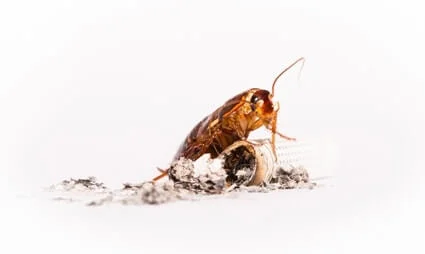
Banned Neonicotinoids
Because of nicotine’s use as an insecticide, neonicotinoids have been developed. This is a class of chemicals that are, at their base structure, similar to nicotine. They work on pests in the same way since they have the same insecticidal properties. However, it is because of their efficacy that certain neonicotinoids have been banned from use.
They have many harmful ecological effects. Such adverse effects include, but are not limited to:
- Honey-bee colony collapse disorder (CCD)
- Reduction in insect populations
- Loss of bird population
Many insects, mammals, and avian species are critical pollinators for a vast amount of plant genera. These various species are responsible for carrying and transferring pollen and potential seeds to other plants and locations. This is done either purposefully or accidentally.
This process is important for the health of the environment. That’s not to mention the health of plant species and many other animals and insects. This extends to humans as we rely on pollinators for successful fruit and vegetable crop development and growth. As such, the use of neonicotinoids has been banned in various places.
Which Neonicotinoids Are Banned?
The classes of neonicotinoids that are banned are dependent on where you live. For example, in the European Union, these neonicotinoids are banned. These include:
- Acetamiprid
- Clothianidin
- Dinotefuran
- Imidacloprid
- Thiamethoxam
In Canada:
- Acetamiprid
- Nitenpyram
- Nithiazine
- Thiacloprid
With that said, there are exceptions. In some cases, they are only allowed in closed-off greenhouses. They are not permitted for outdoor use in these locations.
There are no current bans on the main classes of neonicotinoids in the United States. However, neonicotinoid bans may differ across states. For instance, the state of Maryland prohibits its use.
Should You Use Cigarettes Against Roaches?
Roaches are adaptable and eager to live, even if it means eating cigarettes. This won’t save them from the effects of the nicotine, however. That makes cigarettes seem like a saving grace for anyone with a cockroach infestation.
Sadly, it’s not the safest method. Cigarettes are highly flammable and should not be used indoors. If you wish to remove cockroaches from your home or your yard, there are many safer alternatives.
